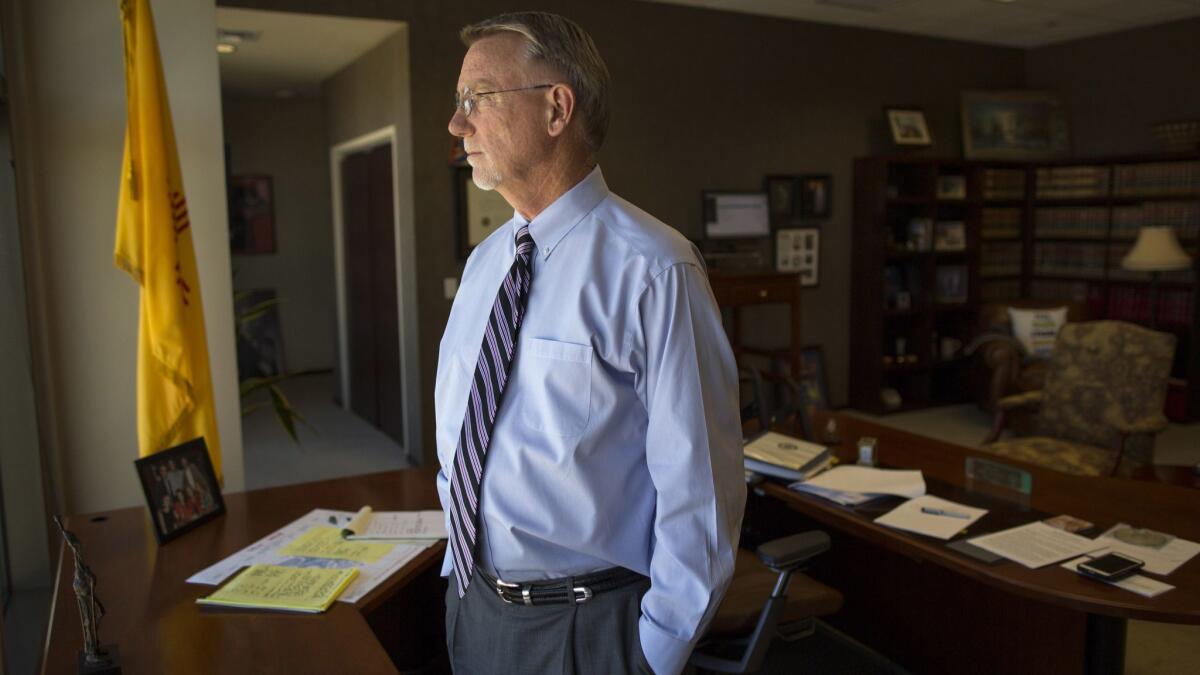Must Reads: Crackdown on immigrants takes a toll on federal judge: ‘I have presided over a process that destroys families’

Reporting from LAS CRUCES, N.M. — Day in, day out, immigrants shuffle into Judge Robert Brack’s courtroom, shackled at the wrist and ankle, to be sentenced for the crime of crossing the border.
The judge hands down sentences with a heavy heart. Since he joined the federal bench in 2003, Brack has sentenced some 15,000 defendants, the vast majority of them immigrants with little or no criminal record.
“See, I have presided over a process that destroys families for a long time, and I am weary of it,” said Brack one day in his chambers in Las Cruces. “And I think we as a country are better than this.”
Brack’s court in rural southern New Mexico is swollen with immigration cases, the migrants brought to his courtroom by the dozen. They exchange guilty pleas for “time served” sentences, usually not more than two months on the first or second offense. They leave his court as felons.
For years, federal authorities in this area along the New Mexico border have taken a distinctively hard-line approach to enforcing immigration law, pursuing criminal charges rather than handling cases administratively. Essentially, authorities here have already been carrying out the “zero tolerance” policy Atty. Gen. Jeff Sessions unveiled in April, when he announced that all immigrants who cross the border will be charged with a crime.
Together, the Border Patrol and U.S. attorney’s office in New Mexico bring charges against nearly every eligible adult migrant apprehended at the state’s border, according to U.S. Customs and Border Protection. That amounted to 4,190 prosecutions last fiscal year.
Vigorous enforcement in New Mexico is a result of ample bed space in the state’s border county jails and a “fast-track” system that prosecutes nonviolent migrants quickly. The state also doesn’t face the volume of illegal crossings that south Texas does, for example.
“It is an efficient process,” says U.S. Attorney for the District of New Mexico John Anderson. “That is one of the key features that allows us to implement 100% prosecutions.”
For Judge Brack, it’s a punishing routine. And it has been building for a long time. Back in 2010, the judge had been on the federal bench seven years, his docket overloaded with immigration cases, when “at some point I just snapped,” he said.
He sat down to compose a letter to President Obama to call for a more compassionate approach to immigration, one that would keep families together and acknowledge that the demands of the labor market drive immigration:
I write today because my experience of the immigration issue, in some 8,500 cases, is consistently at odds with what the media reports and, therefore, what many believe.
I have learned why people come, how and when they come, and what their expectations are. The people that I see are, for the most part, hardworking, gentle, uneducated and completely lacking in criminal history. Just simple people looking for work.
He sent copies of the letter to key congressional leaders and the secretary of the Department of Homeland Security. And he waited.
No other federal criminal court judge comes near Brack’s sentencing record.
In the five years through 2017, Brack ranked first among 680 judges nationwide for his caseload, according to Syracuse University’s Transactional Records Access Clearinghouse, which tracks court data. He sentenced 6,858 offenders — 5,823 of them for felony immigration violations.
It’s a dubious honor for a man who is a devout Catholic and makes plain his moral dilemma in public hearings. He takes seriously his oath to uphold the laws of the United States. But he is a cog in a system he believes is unjust.

Johana Bencomo, director of organizing with the Las Cruces immigrant advocacy group Comunidades en Acción y Fe — Communities in Action and Faith — calls criminal prosecution of migrants “dehumanizing.”
“We’re just this rural community with some of the highest prosecution rates,” she said. “That is Brack’s legacy, no matter how you spin it.”
Advocates of stronger immigration enforcement counter that prosecutions are a crucial element of border security and have contributed to today’s historically low rates of illegal immigration.
“Criminal charges turn out to be one of the most effective tools for dissuading people from trying [to cross] again,” said Jessica Vaughan, director of policy studies at the Washington, D.C.-based Center for Immigration Studies, which advocates for tougher border enforcement.
The effects of this enforcement play out at the five-story, copper-colored federal building in Las Cruces, about 47 miles from the U.S.-Mexico border. Brack’s chambers are on the top floor. In windowless cellblocks on the bottom floor, migrants from Mexico, Central America and Brazil wait to make their initial appearance in a federal magistrate courtroom.
The same scene repeats again and again: The immigrants crowd five broad benches, the juror’s box and the swivel chairs meant for attorneys. They wear the jumpsuits of the four county jails where they are being held: a sea of orange, navy, dark green, fluorescent yellow.
They hear their rights and the charges against them. They eventually plead guilty, to benefit from New Mexico’s fast-track process. Within a month or so, they will find themselves in Brack’s court for sentencing and within days they’ll be deported.
The border used to be wide open, but now it is closed, Brack tells each migrant at sentencing. There are more Border Patrol agents than you can count. Immigration used to be handled as a civil offense, but now it is criminal: a misdemeanor on the first attempt, a felony on the second.
“Everyone gets caught and what’s worse, everyone goes to jail,” he told one migrant, a Mexican woman named Elizabeth Jimenez Rios. “That is not how it has always been, but that is how it is now.”
Their fate is sealed, but Brack still asks the public defenders to tell each migrant’s story.
Elías Beltran, an oil field worker from Mexico, with no criminal history, tried to return to his wife and two kids, U.S. citizens in eastern New Mexico. He lived there 15 years before he was deported.
Andres Badolla Juarez, a farmworker from Mexico, wanted to pick strawberries in California to support his wife, toddler and new baby — all U.S. citizens — in Arizona. He lived in the U.S. 16 years and got deported after an aggravated DUI. It was his fourth failed attempt to cross the border.
Rosario Bencomo Marquez, a 52-year-old maid from Mexico, with no criminal history, hoped to return to her daughter and grandchildren in Santa Fe. She lived in the U.S. 19 years before she was deported.
Brack also sees migrants charged with drug offenses or long criminal records and is unsparing in their punishment. But they are a minority, he said.
“I get asked the question, ‘How do you continue to do this all day every day?’ I recognize the possibility that you could get hard-edged, you could get calloused, doing what I do,” he said. “I don’t. Every day it’s fresh. I can’t look a father and a husband in the eye and not feel empathy.”
Brack, 65, is the son of a railroad-worker father and homemaker mother and earned a law degree at the University of New Mexico. He served as a state judge before being named to the federal bench by President George W. Bush.
In his chambers, above a shelf stacked with books on jurisprudence, Bible study and basketball, hang framed pictures of his forefathers: men who immigrated to the U.S. from England and Prussia. Brack grew up in rural New Mexico, where immigrants — whatever their status — were viewed as “valuable co-workers,” not a threat, he said.
After that first letter to Obama in 2010, he wrote another. And another. And sent copies to other officials again. As the nation periodically heaved toward the possibility of immigration reform, only to leave the issues — and lives of millions — unresolved, Brack continued to write letters to the White House.
He told more heart-wrenching stories about families divided. He kept it up for four years. He pleaded for a civil debate: “See what I see, hear what I hear. Be wary of the loudest, angriest voices.”
He signed each letter with prayer: “May God continue to bless all those who serve our great nation.”
He never got a response. He stopped writing.
And now, after so many grueling years and thousands more immigration cases, Brack has decided enough is enough. He takes “senior status” in July, effectively stepping aside to serve part time.
President Trump will name his replacement.
Villagran is a special correspondent and writes for Searchlight New Mexico.
More to Read
Sign up for Essential California
The most important California stories and recommendations in your inbox every morning.
You may occasionally receive promotional content from the Los Angeles Times.










